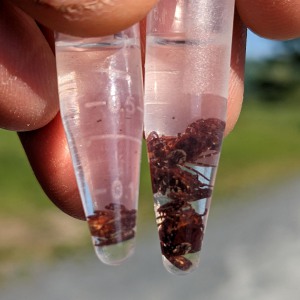What Happened to the Sugar on My Frosted Mini-Wheats?
| Published: 08-21-2018 10:00 PM |
The whole point of Kellogg’s Frosted Mini-Wheats is summed up right there in the name: It’s the frosting. At some point in the mid-20th century somebody at Kellogg’s got the brilliant idea to spray a layer of frosting over an otherwise bland bale of shredded wheat and, voilà, a best-selling cereal was born.
I’ve been a die-hard Frosted Mini-Wheats fan my entire life. They are, in the best possible way, the mullet of breakfast cereals: frosting on the front, whole wheat on the back. Something for everyone, as the Mini-Wheats commercials of the 1980s proclaimed.
But of late my faith in the supremacy of Frosted Mini-Wheats has been shaken. They seem, somehow, less frosted than they used to be? Less sugary. And I’m not the only one noticing — last year an anonymous cereal enthusiast devoted an entire single-serving website to the issue.
Short of analyzing samples of Frosted Mini-Wheats going back decades, there’s no surefire way to determine whether the sugar content of Frosted Mini-Wheats has changed over the years. In response to a Washington Post inquiry, a representative from the Kellogg Media Relations Team said over email that frosting levels haven’t changed in “at least 17 years.” But that doesn’t explain why I remember the Mini-Wheats of my youth as being so much sweeter.
There is, however, one question that’s straightforward enough: When it comes to frosting, how do the name-brand Frosted Mini-Wheats stack up against their generic competitors? Could I maybe get that old-fashioned whole-grain sugar high somewhere else? In a data-driven spirit, I decided to find out.
I found the raw materials for my investigation at my local Walmart: one box of Frosted Mini-Wheats, one box of Great Value Frosted Shredded Wheat, and a bag of Malt-o-Meal Frosted Mini Spooners. Because I lack access to the mad-scientist-grade lab equipment necessary to run a proper sugar content analysis, I turned to a framework more suited to my particular skill set: image analysis.
I sampled 10 biscuits from each of the three frosted wheat products, randomly selecting from different points within each bag. I arranged the biscuits by brand on a sheet of dark paper and then photographed them from directly overhead.
A quick visual inspection does suggest Kellogg’s Frosted Mini-Wheats are more sparsely covered than the other two brands. Also notable is the presence of a “dud” biscuit in the Malt-o-Meal sample that was almost completely bereft of frosting.
Article continues after...
Yesterday's Most Read Articles
 Upper Valley winter shelters kept dozens warm and dry
Upper Valley winter shelters kept dozens warm and dry
 Former principal of South Royalton School released from prison
Former principal of South Royalton School released from prison
 Owner of Friesian horse facility ordered to pay care costs for seized animals
Owner of Friesian horse facility ordered to pay care costs for seized animals
Next, I imported that image into Adobe Illustrator and converted it to a five-color vector graphic. This allowed me to remove the background, isolate each individual biscuit, and define the frosted (lightest color) vs. non-frosted (other colors) areas on each biscuit.
Reassuringly, the lighter areas designated as “frosting” in the processed image line up closely with the visually apparent frosted sections in the raw image.
For the last step, I imported the image into Photoshop to calculate each biscuit’s total area, as well as its frosted area, yielding a frosting percentage for each biscuit.
Alas, my worst Frosted Mini-Wheats suspicions were confirmed. The name-brand cereal had the lowest frosting percentage in the sample, averaging just 48 percent coverage. Great Value’s offering had the most frosting, with an average of 71 percent, while the Malt-o-Meal biscuits averaged 59 percent coverage — still an increase of more than 10 percent over name brand.
One interesting thing to note is that the nutrition labels for all three cereals show identical amounts of added sugar per serving: 11 grams each, although the serving size for each product varies slightly, from 52 grams for the Great Value cereal to 55 grams for the Malt-o-Meal. It may be the case, then, that the differing coverages observed are the product of different frosting techniques, as opposed to differences in sugar content by volume.
Regardless, the differences are big enough to have an impact in the one place where they really matter: your mouth. The name brand Mini-Wheats just feel like they have less sugar.
Have Kellogg’s Frosted Mini-Wheats always been this sparsely covered, or is this a new development? To the anonymous scribe at whathappenedtothesugarfrostingonmyminiwheats.wordpress.com, the answer is clear. “The 1990s heyday of the cereal paralleled the most recent heyday of our economy — a fatter, happier time when mayors of metropolitan cities celebrated excess with us instead of capping its limits at 16 ounces,” they write. “The Frosted Mini Wheat that was is the America that was.”
Who, then, will make Mini-Wheats great again?

 JAG Productions announces closure, citing ‘crisis facing the arts’
JAG Productions announces closure, citing ‘crisis facing the arts’ How a hurricane and a cardinal launched a UVM professor on a new career path
How a hurricane and a cardinal launched a UVM professor on a new career path Out & About: Vermont Center for Ecostudies continues Backyard Tick Project
Out & About: Vermont Center for Ecostudies continues Backyard Tick Project
